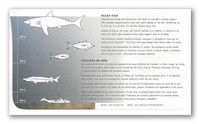
| Name | Value |
|---|---|
| Date of Issue | May 30, 1997 |
| Year | 1997 |
| Quantity | 2,500,000 |
| Denomination |
45¢
|
| Perforation or Dimension | 12.5 x 13 |
| Series | Ocean Water Fish |
| Series Time Span | 1997 |
| Printer | Ashton-Potter Canada Limited. |
| Postal Administration | Canada |
| Condition | Name | Avg Value |
|---|---|---|
|
M-NH-VF
|
Mint - Never Hinged - Very Fine | View price |
|
U-VF
|
Used - Very Fine | View price |



Upon his return to England in 1497, John Cabot reported that fish were so abundant in the waters of North Atlantic (of what is now Newfoundland), one could fold up the nets and retrieve a catch by simply dipping a basket into the sea. By the 16th century, hundreds of ships and thousands of men were drawn by the North American cod and whale fisheries. The fish brought the fleets that resulted in the settlement of Newfoundland and the establishment of numerous villages in the Maritimes. Since then, fishing has remained a vital industry in Canada, and the fish who inhabit our ocean waters have become part of our heritage. Celebrating that heritage, our new Ocean Water Fish stamps celebrate four of the creatures that swim the waters off the Canadian coastline. Collectors will be interested to know that the official first day cover for the Ocean Water Fish stamps will be postmarked in Alberton PEI - the site of the largest great white shark caught in Canadian waters, measuring 5.26 metres in length. Marking a splash on the issue day of May 30, 1997 in a set of four domestic-rate stamps are the great white shark, bluefin tuna, Pacific halibut and Atlantic sturgeon. Ocean enthusiasts of all ages will be impressed with the realism of these stamps. The 1997 Ocean Water Fish stamp design is by Q30 Design Inc. of Toronto, whose earlier stamp work includes the Holocaust stamps and the High Technology stamp set. The selection of the fish was a difficult task but even larger challenge came from the decision to use actual underwater photographs. Although it was extremely difficult to find underwater photographs that were sharp and clear enough to be reproduced in postage stamp size, the design team knew that photography was the best way to convey the qualities of the fish. And the results are stunning. These large, primitive bony fish are found in North American waters from Quebec's Ungava Bay south to Florida. They inhabits coastal waters and ascend rivers from the sea for breeding. Five species of sturgeons are found in Canada. The Atlantic and shortnose are found in Atlantic coastal waters and rivers. The lake sturgeons are found in fresh water east of the Rockies, while white and green sturgeons flourish the Pacific waters and rivers. Caviar is made from Atlantic sturgeon eggs and their flesh is considered delicious fresh or smoked. The Atlantic sturgeon, which can grow over three metres long, is blue black in colour. It has an elongated head and body, a long upper-tail and five rows of bony plates instead of scales. All sturgeon have four barbels in front of a toothless mouth. They use the hairlike appendages to locate food as they move across the bottom. The female Atlantic sturgeon will deposit from 800,000 to 2,4 million eggs in a two-week hatching period. The young sturgeon remain in fresh water up to four years before migrating to the sea. The Atlantic sturgeon can live at least 60 years of age, measure over 265 cm in length and weigh up to 160 kg.